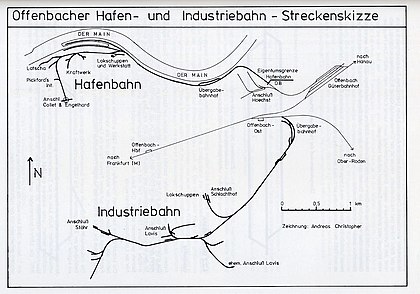Offenbach harbor railway
| Offenbach harbor railway | |||||||||||||||||||||||||||||||||||||||||||||||||||||||||||||
|---|---|---|---|---|---|---|---|---|---|---|---|---|---|---|---|---|---|---|---|---|---|---|---|---|---|---|---|---|---|---|---|---|---|---|---|---|---|---|---|---|---|---|---|---|---|---|---|---|---|---|---|---|---|---|---|---|---|---|---|---|---|
|
Location of the port railway
| |||||||||||||||||||||||||||||||||||||||||||||||||||||||||||||
| Route length: | 9 km | ||||||||||||||||||||||||||||||||||||||||||||||||||||||||||||
| Gauge : | 1435 mm ( standard gauge ) | ||||||||||||||||||||||||||||||||||||||||||||||||||||||||||||
|
|||||||||||||||||||||||||||||||||||||||||||||||||||||||||||||
The Offenbach Port Railway was a railway infrastructure in Offenbach am Main , which connected the Offenbach port to the Offenbach (Main) freight station and the Deutsche Bahn AG network . The preserved systems of the port railway are part of the route of the industrial culture Rhein-Main Offenbach am Main .
history
The Offenbach harbor railway went into operation on December 9, 1902. The tracks from the main train station to the Bürgel district were financed by the state with 350,000 Reichsmarks ; the city paid for the rail connection to the port. A total of 26 points were installed on the then four-kilometer route.
The locomotives of the port railway were serviced in a locomotive shed, the location of which is difficult to reconstruct at the time: During the Second World War , on March 18, 1944, the infrastructure of the Offenbach port was completely destroyed by bombs in an Allied air raid. In 1946 the port railway passed into municipal ownership, the port facilities were rebuilt by 1949, and the port railway also ran again. In the mid-1960s, the port was an important economic factor in the city; mineral oil, coal, gravel and chemicals were handled there.
With the 1973 oil crisis, the local economy began to decline. In 1986 the main tenant British Petroleum gave up Offenbach as a location. On December 31, 1995, the port railway's own operation was given up and the restricted freight traffic was handled with locomotives of the Deutsche Bundesbahn. At the end of the 1990s, BP's oil tanks were dismantled and rail operations were largely suspended; In 1998 the dismantling of the tracks of the port railway began.
Until 2002 the last freight customer in the port, the company Edelstahl-Recycling GmbH, was still regularly served. Then the remaining tracks of the port railway were dismantled.
business
Various locomotives were procured for handling goods in the port. Their maintenance took place in the locomotive shed of the port railway. From 1903 the following locomotives were in use on the port railway:
- Cn2t Maschinenfabrik und Eisengießerei Darmstadt 59/1874 240 HP, bought in 1903 by Kronberger Bahn , sold in 1908 to Adlerwerke Frankfurt
- Cn2t Henschel & Sohn , Kassel 8620/1908 approx. 200 HP, Thuringia type, delivered new in 1908, sold in 1953
- Cn2t Henschel & Sohn , Kassel 18296/1921 350 HP, type Bismarck , former Henschel factory locomotive No. 11, bought in 1929, sold in 1956 to the company Klöckner-Mannstaedt-Werke in Troisdorf
- B-dh Gmeinder 2582/1940 type N200, 200 HP, acquired in 1953, sold to private for Offenbacher Lokalbahn e. V.
- C-dh Deutz 56435/1956 type A6M 428, 250 HP, sold to Italy in July 1995
- C-dh Deutz 56509/1957 type A6M 428, 250 hp, redrawn as 1 in 1980, sold to Italy at the end of 1996
present
A single track, only a few dozen meters long, on Offenbach's banks of the Main, the cultural track, is reminiscent of the Offenbach port railway . A closed freight wagon that is used for cultural events stands on this track. At the eastern end of the track, a work of art in the form of a high helix was created from the rails. Starting from the Offenbach freight yard , there are still around one hundred meters of track, which is still clearly visible in the freight yard itself, but is then completely overgrown. The non-profit Offenbacher Ausbildungs- u. Employment company mbH used the former locomotive shed of the port railway to train young people in metal professions. Until 2002 the building was also used for heavy metal events. In 2004, the Hafen 2 cultural center opened there , where, among other things, film screenings and concerts took place. In 2015 the engine shed was demolished.
Web links
- Pictures of the Offenbach port railway (part 1) on turntable-online.de
- Pictures of the Offenbach port railway (part 2)
- Life in Offenbach - signpost, port railway on offenbach.de
- Locomotive shed gives way to Hafenallee , article on op-online.de
Individual evidence
- ↑ a b Local route guide no. 9, object no. 55. (PDF, 507 kB) In: Route der Industriekultur Rhein-Main Offenbach am Main . Kultur-Region Frankfurt-Rhein-Main, July 2017, accessed on March 12, 2019 .
- ↑ a b F. Summer: The last days of the engine shed . Article of the Frankfurter Rundschau, accessed on March 11, 2019
- ^ A. Christopher, Turntable Online Forum
- ^ Hofmann, Michael: The railway in Offenbach and in Rodgau . 1st edition. DGEG, ISBN 978-3-937189-08-6 .




